
Hydrogen bonding in water.
- Subject:
- Biology
- Chemistry
- Life Science
- Physical Science
- Material Type:
- Lesson
- Provider:
- Khan Academy
- Provider Set:
- Khan Academy
- Author:
- Sal Khan
- Date Added:
- 07/01/2015

Hydrogen bonding in water.
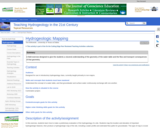
In this exercise, students learn how to make a preliminary evaluation of the hydrogeology of
a site. Students map the location and elevation of important hydrogeologic features, then
produce a hydrogeologic map of the site, including a water profile and estimated
flow paths
for groundwater. This type of map is crucial for evaluating potential sources of groundwater,
as well as potential sources of groundwater contamination.
(Note: this resource was added to OER Commons as part of a batch upload of over 2,200 records. If you notice an issue with the quality of the metadata, please let us know by using the 'report' button and we will flag it for consideration.)
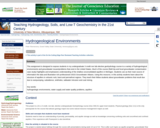
This assignment is designed to expose students in my undergraduate 3 credit non lab elective geohydrology course to a variety of hydrogeological environments and groundwater issues/problems that exist in the United States. Much of the course (field trip and local groundwater contamination case study) highlights and emphasizes understanding of the shallow unconsolidated aquifers in Michigan. Students use as their main source of information the data and illustration rich professional USGS Groundwater Atlases. Using this resource, in this activity students learn about the structure of aquifers in volcanic rock, karst and permafrost regions. They teach their fellow students about groundwater problems that result due due to overpumping, subsidence, sinkholes, saltwater intrusion and coal mining.
Key words:
hydrogeologic environments, water supply and water quality problems, aquifers
(Note: this resource was added to OER Commons as part of a batch upload of over 2,200 records. If you notice an issue with the quality of the metadata, please let us know by using the 'report' button and we will flag it for consideration.)
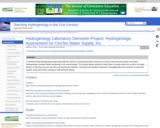
This activity is a single, semester-long project that involves a hydrogeologic assessment of a property in Central Texas. The project is presented in the lab portion of a hydrogeology class, and it is broken into several separate steps. Each step is treated as a separate assignment, however, the data and results associated with each assignment are applied towards the overall goal of the project. Students are required to maintain a file and a master Excel workbook containing all information, data, and results from each of the steps. All this information is then used to develop an analytical model that simulated drawdowns in the aquifer. This model is used to answer the primary question associated with the project. The results are then documented in a technical report.
(Note: this resource was added to OER Commons as part of a batch upload of over 2,200 records. If you notice an issue with the quality of the metadata, please let us know by using the 'report' button and we will flag it for consideration.)
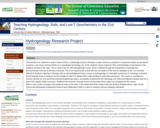
This activity is for students to work in teams (2012) or individually (2013) to develop a project (such as a physical or numerical model), survey based research, case study, technical briefs on a remediation technology, etc. of the students' choice, based on their understanding of and interest in the subjects covered in the class. This is used in the GL 199 Hydrogeology course, which is offered through the Department of Geology and Environmental Sciences at Norwich University. This is an experimental course that has not made it to the course catalogue as yet. It is currently offered to students majoring in Geology, with an acknowledgement that a course in hydrogeology is a desirable component of a Geology curriculum. Environmental Science students are encouraged to take it to deepen their understanding of subsurface processes. This course is considered a science elective for Civil and Environmental Engineering majors, and greatly complements the Hydrology, and Soils and Materials classes that are a part of the regular CE&E curriculum. Students from freshmen through seniors across these three majors are accepted into the course.
With a cross section of majors and academic years in the class, it was determined that a project that has students thinking about a topic of their choice and developing fundamental research and collaboration skills is critical to meeting common workplace demands.
(Note: this resource was added to OER Commons as part of a batch upload of over 2,200 records. If you notice an issue with the quality of the metadata, please let us know by using the 'report' button and we will flag it for consideration.)
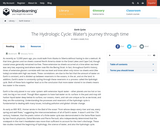
This module discusses the hydrologic cycle and its impacts on the planet Earth. Additionally, the module addresses connections between the hydrologic cycle, climate and the impacts humans have had on the cycle.
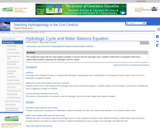
This exercise is designed to evaluate the students' understanding of both the hydrologic cycle and the water budget (mass balance) equation. In my course, the exercise is the students' first exposure to models in the course. While the exercise may seem basic, students gain experience in creating conceptual models and then generating mathematical models from the conceptual model. The exercise provides students with an introduction (or refresher) to some basic Excel formulas. Finally, the exercise can be modified to include more "what if" scenarios that require critical thinking and analysis from the students.
(Note: this resource was added to OER Commons as part of a batch upload of over 2,200 records. If you notice an issue with the quality of the metadata, please let us know by using the 'report' button and we will flag it for consideration.)

This course, is designed to be a descriptive and analytical overview of water organs, availability, location and flow. It will be examined in the light of problems, possibilities and policy and consider historical perspectives.
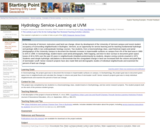
At the University of Vermont, instructors used land use change, driven by development of the University of Vermont campus and recent student occupancy of surrounding neighborhoods in Burlington, Vermont, as an opportunity for service learning and for teaching fundamental hydrologic and geologic skills. Students from a Geomorphology class, Geohydrology class and student senior research projects all worked on the preoject. In each of these studies, students worked closely with City and University staff and presented results at local forums, professional national meeting, and on the World Wide Web. These service-learning projects have received positive feedback from the students, city officals, and community members.
(Note: this resource was added to OER Commons as part of a batch upload of over 2,200 records. If you notice an issue with the quality of the metadata, please let us know by using the 'report' button and we will flag it for consideration.)
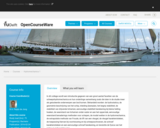
In dit college wordt een introductie gegeven van een groot aantal facetten van de scheepshydromechanica en hun onderlinge samenhang zoals die later in de studie meer als geisoleerde onderwerpen aan bod komen. Behandeld worden: de hydrostatica, de geometrie beschrijving van het schip, inleiding lijnenplan, het begrip stabiliteit, de stabiliteit van drijvende lichamen, eenvoudige stabiliteit berekening bij kleine helling hoeken, de weerstand van lichamen onder water en aan het oppervlak, eenvoudige weerstand benaderings methoden voor schepen, de model wetten in de hydromechanica, de extrapolatie methode van Froude, de lift van een vleugel, de vleugel karakteristieken, de toepassing hiervan bij voortstuwing en bij scheepsschroeven, de schroef karakteristieken en een eenvoudige schroef berekening, en tenslotte de fysica van het zeilen en zeilvoortstuwing. Leerdoelen De student kan: 1. de basis van systeem analyse beschrijven (buitenwereld, interfaces, beperkingen, objecten, relaties enz.) 2. maritieme systemen zoals schip/motor/schroef beschrijven en modelleren met behulp van beperkte systeem analyse methodologie; eenvoudige maritieme systemen modelleren door onderverdeling in subsystemen en componenten 3. evenwicht condities van maritieme systemen bepalen en kwalitatief analyseren 4. de definities en belangrijkste karakteristieken van weerstand, voortstuwing en manoeuvreren (snelheid, weerstand, vermogen, RPM, draaicapaciteit) begrijpen en toepassen 5. de relaties tussen algemeen vloeistof dynamica en scheepshydromechanica (bijv. lift/aerodynamica/zeilen; visceuze stroming/Reynolds getal/volgstroomvelden/voortstuwingsrendement; laminair & visceuze stroming/weerstand; niet visceuze stroming/golf patronen/weerstand) beschrijven 6. de achtergrond van de belangrijkste schaal regels (Newton, Froude, Reynolds) d.m.v dimensie analyse uitleggen 7. schaalregels voor schaalmodel experimenten in een sleeptank toepassen en potentiĚÇle complicaties identificeren
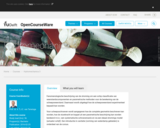
Fenomenologische beschrijving van de stroming om een schip classificatie van weerstandscomponenten en parametrische methoden voor de berekening van de scheepsweerstand. Daarnaast wordt uitgelegd hoe de scheepsweerstand experimenteel bepaald kan worden.
Voor scheepsschroeven wordt aangegeven hoe de complete geometrie beschreven kan worden, hoe de stuwkracht en koppel uit een parametrische beschrijving kan worden berekend m.b.v. een systematische schroevenserie en via een ideaal stromings model (actuator schijf). Een introductie in cavitatie (vorming van waterdamp gebieden) is onderdeel van de cursus.
![Hydrophilic Porphyrins based Chemosensors for First Transition Series Metal Ions [Chemistry]](https://img.oercommons.org/160x134/oercommons/media/upload/materials/screenshots/materials-course-280665.png)
General Chemistry is a two-semester course (General Chemistry I, SCC 201 and General Chemistry II, SCC 202) required for majors in Biology and Environmental Sciences.
This lab experiment, aligned to LaGuardia Community College‰Ûªs Inquiry and Problem Solving Core Competency and Written Communication Ability was designed for General Chemistry I (SCC 201 Honors) course. Honors courses in LaGuardia emphasize critical thinking, analytical writing, and introduce students to research. This lab experiment provides an opportunity for students to engage in hands-on laboratory work, to develop laboratory skills, and to conduct research in the classroom by using two water soluble porphyrins to detect transition metal ions in a solution and on a paper support. Overall, this experiment was designed to meet the demand for undergraduate research experiences and to engage all the students in addressing a research question or problem that is of interest to the scientific community.
In order to demonstrate their learning, students write a formal lab report which includes an understanding of experiment procedures (methods and techniques), safety hazards, instrumentation, understanding of concepts and theories gained by performing the experiment, collecting data through observation and/or experimentation, interpretation of the data (Ultraviolet-visible spectra), analysis of the data in tables and graphs, and drawing conclusions and perspective from the experiment. The knowledge students gain during this lab experiment will be useful to connect with future chemistry courses and can also be utilized to do research. The lab write-up is deposited for the assessment of the Written Communication Ability to which SCC 201 is aligned.
This experiment also raises awareness about a global concern. Students detect transition metal ions in aqueous solutions by use of porphyrins. Due to rapid growth in technology and industrialization, transition metals are used in large amounts in a variety of electronic products. The improper preservation of the industrial wastes leads to accumulation of these metals into water resources, which can create danger to human health and the environment. Therefore, there is a need to carefully monitor and frequently detect transition metal ions content in the environment.
This lab experiment was implemented in an Honors section of General Chemistry SCC 201 and was worth about 3.5% of the final grade. The students are likely to spend 3 hours completing the experiment in the lab and another 3-4 hours completing the lab write-up.
The Program Goals that this assignment targets:
1. To provide training to the students in various lab techniques and how to utilize these techniques to conduct research.
The Student Learning Objective (s) that this assignment targets:
1. Students will have an enhanced conceptual understanding of the theory to practice relationship and will achieve higher level reasoning skills.
2. Students will be able to develop their practical competence in laboratory work.
3. Students will be able to collect data through observation and/or experimentation, preparation of solutions of known concentration, characterize the compounds by UV-vis spectra, and draw conclusions and perspective of the experiment.
4. Communicate their results through the formal lab report format of: Introduction, Chemicals, Procedure, Data, Discussion and References.
LaGuardia‰Ûªs Core Competencies and Communication Abilities
The Course Objective (s) that this assignment targets:
1. Based on the principles of environmental chemistry, students will be able to detect the transition metal ions using a porphyrin as a sensor and explore the complex connections between chemistry and real world issues.
2. Observe, collect, analyze and interpret experimental data and graph the UV visible spectra using Microsoft Excel.
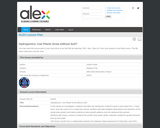
In this hands-on investigation, students will utilize the hydroponic method to grow a bean plant from a bean seed. Over the course of a 2 week time period, students will make detailed observations and sketches of the actual bean growth and make predictions about growth patterns over the weekend time periods. Students will create a cartoon to defend the position that plants obtain materials needed for growth primarily from air and water. This lesson results from a collaboration between the Alabama State Department of Education and ASTA.
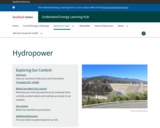
Hydropower, also known as hydroelectricity, is a semi-renewable resource that uses the flow of water to generate electricity. There are two major approaches to generating electricity from hydropower: storage hydroelectric systems and run-of-river systems. Hydro can also be used to store electricity in systems called pumped storage hydropower.

Detailed, annotated example of Socratic questioning for topics of hydrologic cycle, streamflow hydrographs, and impacts of land-use change on streamflow.
(Note: this resource was added to OER Commons as part of a batch upload of over 2,200 records. If you notice an issue with the quality of the metadata, please let us know by using the 'report' button and we will flag it for consideration.)
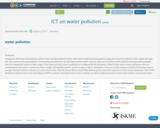
Categories
Although interrelated, surface water and groundwater have often been studied and managed as separate resources. Surface water seeps through the soil and becomes groundwater. Conversely, groundwater can also feed surface water sources. Sources of surface water pollution are generally grouped into two categories based on their origin.
Point sources
Point source pollution at a shipyard in Rio de Janeiro, Brazil.
Point source water pollution refers to contaminants that enter a waterway from a single, identifiable source, such as a pipe or ditch. Examples of sources in this category include discharges from a sewage treatment plant, a factory, or a city storm drain. The U.S. Clean Water Act(CWA) defines point source for regulatory enforcement purposes. The CWA definition of point source was amended in 1987 to include municipal storm sewer systems, as well as industrial storm water, such as from construction sites.
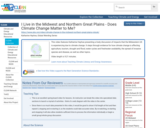
This video features Katharine Hayhoe presenting a lively discussion of impacts that the Midwestern US is experiencing due to climate change. It steps through evidence for how climate change is affecting agriculture, tourism, drought and flood, water cycles and freshwater availability, the spread of invasive species and disease, as well as other topics.
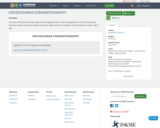
The topic of illstration is Ion Exchange Chromatography which contain two application of it one is softening hardness of water and other is determination of organic acid from cosmetics. The illustration is made in "Miro" app.

Ice-Dying is a twist on the classic tie-dye of the mid-1960s. In this lab, students will be combining the tie-dyeing techniques with the properties of slow melting ice. As the ice melts, the melted water carries the dye into the fabric, distributing the colors. This is ideally a 3-period lab (52-minute classes). Day 1 consists of instructions, a teacher demo, and planning. Day 2 is when the students get to tie, dye, and prep their designs. Day 3 students get to rinse out their fabric and wash it.
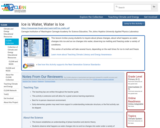
This lesson invites young students to inquire about phase changes, about what happens as water changes into ice and as ice changes into water, observing ice melting and freezing under a variety of conditions.